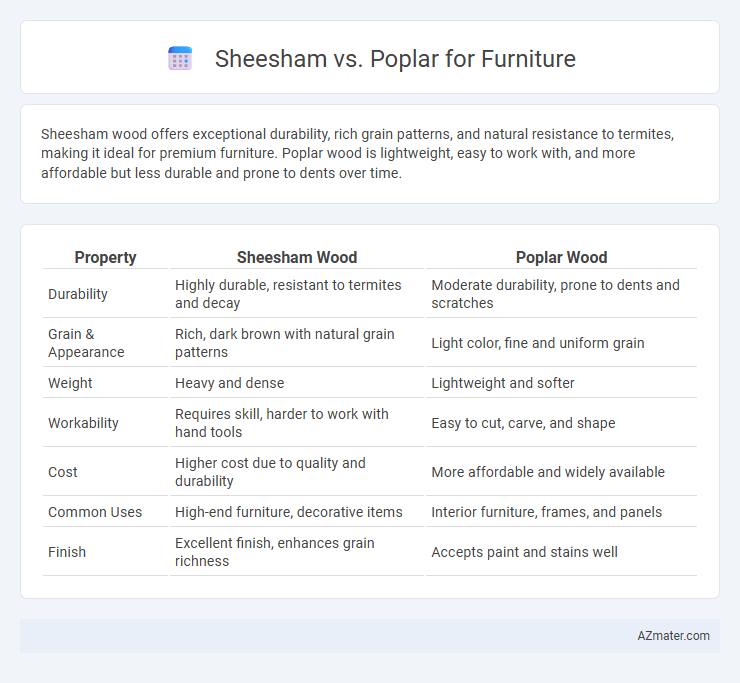Sheesham wood offers exceptional durability, rich grain patterns, and natural resistance to termites, making it ideal for premium furniture. Poplar wood is lightweight, easy to work with, and more affordable but less durable and prone to dents over time.
Table of Comparison
| Property | Sheesham Wood | Poplar Wood |
|---|---|---|
| Durability | Highly durable, resistant to termites and decay | Moderate durability, prone to dents and scratches |
| Grain & Appearance | Rich, dark brown with natural grain patterns | Light color, fine and uniform grain |
| Weight | Heavy and dense | Lightweight and softer |
| Workability | Requires skill, harder to work with hand tools | Easy to cut, carve, and shape |
| Cost | Higher cost due to quality and durability | More affordable and widely available |
| Common Uses | High-end furniture, decorative items | Interior furniture, frames, and panels |
| Finish | Excellent finish, enhances grain richness | Accepts paint and stains well |
Introduction to Sheesham and Poplar Wood
Sheesham wood, also known as Indian Rosewood, is highly valued in furniture making for its rich color, durability, and natural resistance to decay and termites. Poplar wood is a lightweight, soft hardwood favored for its affordability, ease of workability, and smooth finish, often used in painted or veneered furniture. Choosing between Sheesham and Poplar depends on the desired strength, appearance, and budget for the furniture project.
Botanical Overview and Origin
Sheesham, also known as Indian Rosewood (Dalbergia sissoo), is a hardwood native to the Indian subcontinent, prized for its dense grain and natural durability. Poplar (Populus spp.) is a fast-growing, soft hardwood found primarily in North America and parts of Europe, characterized by a light color and a straight, uniform grain pattern. Sheesham trees thrive in dry, tropical climates while Poplar grows well in temperate zones, reflecting their botanical adaptations and influencing their use in furniture crafting.
Physical Appearance and Grain Patterns
Sheesham wood features a rich, dark reddish-brown color with striking natural grain patterns, including swirls and irregular lines that add depth and character to furniture pieces. Poplar wood is generally lighter in color, often pale yellow or white with subtle green or brown streaks, and displays a more uniform, straight grain pattern that offers a clean and smooth appearance. The bold, intricate grain of Sheesham creates a more dramatic visual impact compared to the understated, consistent look of Poplar, making each suitable for different aesthetic preferences in furniture design.
Durability and Strength Comparison
Sheesham wood, also known as Indian rosewood, offers superior durability and strength compared to Poplar, making it ideal for heavy-use furniture. Its dense grain structure provides excellent resistance to wear, scratches, and warping, ensuring long-lasting performance. Poplar, while lightweight and easy to work with, is softer and less resistant to dents and impacts, limiting its use for high-stress furniture applications.
Workability and Ease of Crafting
Sheesham wood offers excellent workability due to its dense grain and smooth texture, making it ideal for intricate carving and detailed furniture designs. Poplar is softer and lighter, allowing easier cutting and shaping, which suits mass production and simpler furniture pieces. Both woods provide ease of crafting, but Sheesham's durability caters to long-lasting, high-quality furniture while Poplar favors affordability and speed.
Resistance to Pests and Rot
Sheesham wood offers superior resistance to pests and rot due to its natural oils and dense grain, making it highly durable for furniture in humid environments. Poplar, being softer and less dense, is more susceptible to insect attacks and moisture damage, requiring additional treatment for longevity. When prioritizing durability against pests and rot, Sheesham is the preferred choice for long-lasting furniture.
Cost and Market Availability
Sheesham wood is generally more expensive than Poplar due to its durability, rich grain, and natural resistance to pests, making it a premium choice in the furniture market. Poplar is widely available and valued for its affordability and ease of use, often chosen for budget-friendly furniture or pieces requiring paint or veneer finishes. The higher cost of Sheesham reflects its rarity and quality, while Poplar's market abundance ensures consistent supply and lower prices.
Environmental Impact and Sustainability
Sheesham wood, harvested from Dalbergia species, is known for its durability and natural resistance to decay, making it a long-lasting and sustainable choice when sourced from responsibly managed forests. Poplar, a fast-growing hardwood, offers a renewable option with a lower environmental footprint due to its rapid growth cycle and ability to regenerate quickly after harvesting. Choosing furniture made from FSC-certified Sheesham or Poplar ensures reduced impact on deforestation while supporting sustainable forestry practices.
Best Uses in Furniture Applications
Sheesham wood, known for its rich grain and durability, is ideal for high-quality, ornate furniture such as cabinets, dining tables, and decorative chairs that require long-lasting strength and aesthetic appeal. Poplar is best suited for painted furniture, plywood, and indoor pieces like drawers, shelves, and frames due to its lightweight nature and smooth surface, which accepts paint and stains well. The choice between Sheesham and Poplar depends on the desired finish and usage, with Sheesham preferred for solid, polished wooden furniture and Poplar for cost-effective, versatile indoor applications.
Sheesham vs Poplar: Which is Better for Your Furniture?
Sheesham wood, renowned for its durability and rich grain patterns, offers superior resistance to termites and moisture compared to Poplar, making it ideal for long-lasting furniture. Poplar, while lighter and more affordable, lacks the dense hardness and natural oils of Sheesham, which often results in less resistance to wear and damage over time. Choosing between Sheesham and Poplar hinges on prioritizing either longevity and aesthetic appeal or cost-effectiveness and ease of workability for your furniture.

Infographic: Sheesham vs Poplar for Furniture
 azmater.com
azmater.com